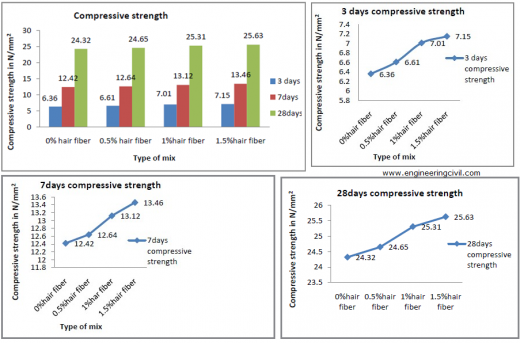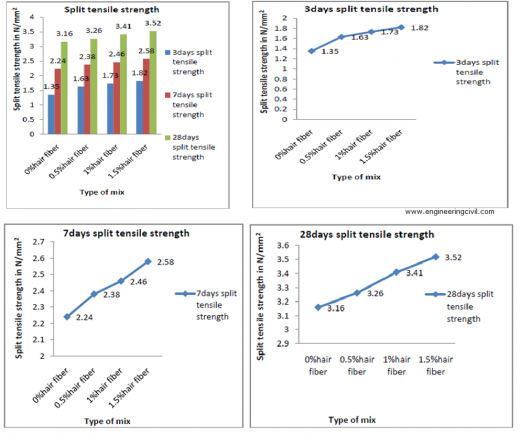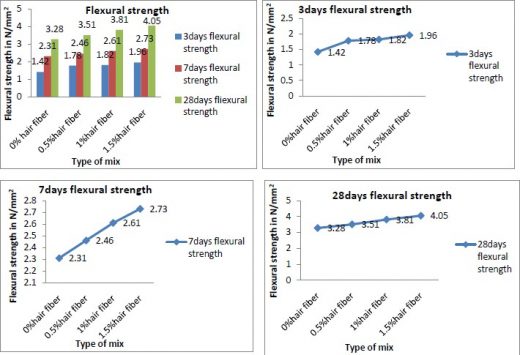By
G. Ajaya Kumar O. Ganesh Kumar K. Damodar C. Jayasree Simpa Karmakar
Sai Ganapathi Engineering College, Visakhapatnam, Andhra Pradesh, India
Abstract— Since the ancient times, many researches and advancements were carried to enhance the physical and mechanical properties of concrete. Fiber reinforced concrete is one among those advancements which offers a convenient, practical and economical method for overcoming micro cracks and similar type of deficiencies. Since concrete is weak in tension hence some measures must be adopted to overcome this deficiency. Human hair is generally strong in tension; hence it can be used as a fiber reinforcement material. Human hair Fiber is an alternative non-degradable matter available in abundance and at cheap cost. It also reduces environmental problems. Also addition of human hair fibers enhances the binding properties, micro cracking control, Imparts ductility and also increases swelling resistance. The experimental findings in our studies would encourage future research in the direction for long term performance to extending this cost of effective type of fibers for use in structural applications. Experiments were conducted on concrete cubes, cylinders and beams of standard sizes with addition of various percentages of human hair fiber i.e., 0%, 0.5%, 1% and 1.5% by weight of cement, fine & coarse aggregate and results were compared with those of plain cement concrete of M-20 grade. For each percentage of human hair added in concrete, four cubes, three cylinders and three beams were tested for their respective mechanical properties at curing periods of 3 , 7 and 28 days. Optimum hair fiber content was obtained as 1.5% by weight of cement.
Keywords: Human Hair, Concrete, Fibre Reinforcement
INTRODUCTION
Fiber Reinforced Concrete (FRC) is concrete containing fibrous material which increases as structural and is gaining importance. It contains short discrete fibers that are uniformly distributed and randomly oriented. The concept of using fibers as reinforcement is not new. Fibers have been used as reinforced since ancient times. Historically, horsehair was used in mortar and straw in mud bricks. In the early 1900s, asbestos fibers were used in concrete, and in the 1950s the concept of composite materials came into being and fiber reinforced concrete was one of the topics of interest. Later, the use of asbestos for concrete reinforcement was discouraged due to the associated health risks. New materials like steel, glass, and synthetic fibers replaced asbestos for reinforcement.
A fiber is a small piece of reinforcing material possessing certain characteristics properties. Addition of fibers to concrete influences its mechanical properties which significantly depend on the type, length and percentage of fiber. Generally, concrete is weak in tension and has a brittle character. Hence fibers are added to increase its tensile strength and improve the characteristics of construction materials.
Fibers are usually used in concrete for the following reasons:-
1) To control cracking due to both plastic shrinkage and drying shrinkage.
2) They also reduce the permeability of concrete and thus reduce bleeding of water.
3) They produce greater impact, ductility, strength, abrasion and shatter resistance in concrete.
4) The fineness of the fibers allows them to reinforce the mortar fraction of the concrete, delaying crack formation and propagation.
This fineness also inhibits bleeding in the concrete, thereby reducing permeability and improving the surface characteristics of the hardened surface. But use of higher percentage of fiber is likely to cause segregation and harshness of concrete and mortar.
The fiber is often described by a convenient parameter called aspect ratio. The aspect ratio of the fiber is the ratio of its length to its diameter. Its value varies for different fibers. Reinforced Concrete with high aspect ratio was found to have improved effectiveness. The modulus of elasticity of matrix must be much lower than tough fiber for efficient stress transfer. The interfacial bond between the matrix and the fiber also determine the effectiveness of stress transfer, from the matrix to the fiber. A good bond is essential for improving tensile strength of composite. Basically, the hair thread has a cylindrical structure, highly organized, formed by inert cells, most of them keratinized and distributed following a very precise and pre-defined design. Hair forms a very rigid structure in the molecular level, which is able to offer the thread both flexible and mechanical resistance. Human hair has about 65-95% of its weight in proteins, 32% of water, lipid pigments and other components Why human hair a fiber?
Hair is used as fiber reinforcing material in concrete for the following reasons
1) It has high tensile strength which is equal to that of copper wire with similar diameter.
2) Hair, a non-degradable matter is creating an a environmental problem so it used as fibro reinforcing material can minimize the problem.
3) It also available in abundance and at a very low cost.
4) It reinforces the mortar and prevents it from spelling.
In this experimental study, human hair fibers are incorporated into concrete at content of 0.5, 1 and 1.5% by weight of cement. Cubes, beams and cylindrical specimens are casted and cured properly for evaluating various mechanical properties. These specimens made of human hair fiber reinforced concrete are tested at 3, 7 and 28days and the change in mechanical properties when compared to plain cement concrete is observed.
II. LITERATURE REVIEW
This chapter presents the background information on the issues to the to be consider in the present research work and to focus the significance of the current study.
Dr. Sinan abdulkhaleq yaseen, University of salahaddin published a paper on “An Experimental Investigation into the mechanical properties of New Natural Fiber Reinforced Mortar” in 2013. This paper highlights use of human hair fiber (HHF) as reinforced material in cementitious material. Tests were carried to study the influence of fiber content on the compressive strength, splitting tensile strength, flexural strength and load deflection was presented for two w/c ratios (0.6 and 0.7). Energy absorption capacity and ductility factor were improved considerably with the fiber content increased, which makes using the HHF suitable for seismic force resistant structures. Jain.D and Kothari.A, it is observed that there is remarkable increment in properties of concrete according to the percentages of hairs by weight of in concrete. When M20 concrete with 1% hair is compared with the plain cement concrete, it is found that there is an increase of 10% in compressive strength and 3.2% in flexural strength. When M20 concrete with 1.5% hair is compared with plain cement concrete, it is found that there is an increase of 22% in compressive strength and 8.6% in flexural strength. When M20 concrete with 1% hair is compared with the plain cement concrete, it is found that there is no increase in compressive strength and 2% in flexural strength. When M20 concrete with 1.5 % hair is compared with the plain cement concrete, it is found that there is an increase of 8.8 % in compressive strength and 5.5 % in flexural strength. When M25 concrete with 1% hair is compared with the plain cement concrete, it is found that there is an increase 4.6% in compressive strength and 3% in flexural strength. When M25 concrete with 1.5% hair is compared with the plain cement concrete, it is found that there is an increase of 11% in compressive strength and 4% in flexural strength.
Nila V. M, Raijan K. J, Susmitha Antony, Riya Babu M, Neena Rose Davis, According to the test performed it is observed that there is remarkable increment in properties of concrete according to the percentages of hairs by weight of concrete. There was an overall increase of 1 – 12% in the compressive strength of concrete and up to 5% in the flexural strength of concrete test specimens by the addition of hair fibers in different quantities. It is well observed that the maximum increase is noticed in the addition of 2% hair fiber, by weight of concrete, in all the mixes. It is concrete mixes, making the hair fiber reinforced concrete best suitable to u the applications with those concrete mixes. Crack formation and propagation are very much reduced showing that FRC can have its applications in seismic resistant constructions.
Yadollah Batebi, Alireza Mirzagoltabar, Seyed Mostafa Shabanian and Sara Fateri, Department of Civil Engineering, Babol University of Technology. Basically most of cement based mixtures are likely shrinking. Use of fibers is not a new idea in this case. Previously, there were evidences that horse hair, straw and cotton fibers were used in mud and mortars in ancient times. Then, utilizing these fibers in concrete mixtures may increases concrete workability and decreases cracks. Due to nano cross-section of hair and its proper tensile strength this project investigates its application to reduce the shrinkage of concrete mixtures. For this purpose, human hair fibers were used in 0.4 and 0.8 and 1.2 weight percentage and the length of the fibers in each case varied between 15 and 60 millimeters. Results are shown as considerable amount of hair may reduce in the shrinkage in the hair reinforced concrete.
III. METHODOLOGY
In this study mixes, we are planned to make with fiber with varying proportion of 0.5%, 1% and 1.5%.Control mix was taken with 0%fiber.
A. Collection of Raw Materials
The materials used in this study are: Ordinary Portland cement (OPC): 53grade ACC Cement Human hair fiber: Human hair fiber collected from the saloon shop in the Visakhapatnam district.
These fibers are chapped into 3.5cm length and washed these fibers in the acetone for washing or polishing purposes.
1) Water
Collected from the local fresh water sources
2) Fine Aggregate
River sand passing through 4.75mm sieve size
3) Coarse Aggregate
Aggregate sizes of 20mm
4) Basic Test Results of Materials
For all the materials used in the project following basic tests were conducted according to the IS specifications.
B. Basic Test Results for Cement
– fineness of cement=7.16%
– specific gravity of cement=3.195
– Normal consistency of cement=31.5%
– Penetration depth for initial setting time=5mm
– Penetration depth for finial setting time=32mm
C. Basic Test Results for Fine Aggregate
– Sieve analysis for fine aggregate=zone-1
– Specific gravity of fine aggregate=2.519
– Water absorption for fine aggregate=0.2
D. Basic Test Results for Coarse Aggregate
– Sieve analysis for coarse aggregate=table 2 of IS 383- 1970
– Specific gravity for coarse aggregate=2.707
– Water absorption for coarse aggregate=1.689
IV. EXPERIMENTAL WORK
A. Mixes
Four mixes are planned by cement content with human hair in percentages of 0, 0.5, 1, 1.5 by weight of cement material was incorporated in all the mixes. Plain concrete in which 0% human hair fiber was taken as control mix. For each mix 4Cubes of 150x150x150mm size and 3Cylinders of 150mm dia and 300mm length and 3 beams of 700mm x150mm x150mm sizes were casted.
Mix Proportions (M20 Grade, As per IS 10262-2009)
| Material | Water | Cement | Fine Aggregates | Coarse Aggregates |
| In kg/m3 | 186 | 294 | 724.888 | 1169.640 |
| Ratio | 0.5 | 1 | 2.466 | 3.978 |
Mix proportions for human hair fiber reinforced concrete blended with concrete (M20grade): Taking control mix proportions as reference, mix proportions for other mixes were calculated. Here, the mix proportions for the mix in which and 0.5% fiber was incorporated are given below.
| Material | Water | Cement | Fine Aggregates | Coarse Aggregates |
| In kg/m3 | 186 | 294 | 724.888 | 1173.946 |
| Ratio | 0.5 | 1 | 2.466 | 3.992 |
Casting the specimens taking the control mix design (i.e. 0% fiber) as reference weights of materials are calculated as shown above. In all the concrete mixes human hair fiber was varied in the percentages of 0.5%, 1.0%, 1.5%, by the weight of cement material content was incorporated for the w/b ratio 0.5. Total 16 Cubes (150x150x150mm), 12Cylinders (150mm dia and 300mm length) and 12beams (700mmx150mmx150mm) for all the 4mixes including control mix.
Mix 1: 0% fiber
Mix 2: 0.5% fiber
Mix 3: 1.0% fiber
Mix 4: 1.5% fiber
B. Workability
To determine workability of fresh concrete the following tests were conducted.
1) Slump cone test
2) Compaction factor test
C. Tests
To know the hardening properties of concrete the following tests are conducted on the specimens for 3, 7 and 28 days from time of mixing the water to the dry materials
1) Compressive strength test (Cubes)
2) Split tensile strength test (Cylinders)
3) Flexural strength test (beams)
V. RESULTS
A. Workability
Workability of human hair fiber reinforced concrete is decreased than the control mix, due to the presence of human hair fiber. The results of workability are shown in the following Table-1.
| S.No. | Mix No. | Slump value (cm) | Compaction Factor |
| 1 | Mix 1 | 5 | 0.9 |
| 2 | Mix 2 | 6 | 0.92 |
| 3 | Mix 3 | 6 | 0.93 |
| 4 | Mix 4 | 4 | 0.95 |
Table 1: Results of Workability of Mixes
B. Compressive Strength
The compressive strength of concrete is determined by testing the cubes under compressive testing machine. The results of compressive strength are shown in the Table-2. Maximum compressive strength occurred at (1.5%fiber) and it is nearer to the target strength.
| S.No. | For Days |
Compressive strength in N/mm2 |
|||
| Mix 1 | Mix 2 | Mix 3 | Mix 4 | ||
| 1 | 3 | 6.36 | 6.61 | 7.01 | 7.15 |
| 2 | 7 | 12.42 | 12.64 | 13.12 | 13.46 |
| 3 | 28 | 24.32 | 24.65 | 25.31 | 25.63 |
Table 2: Results of Compressive Strength

Fig. 4: Variation of Hair Fiber Content v/s Compressive Strength at 3, 7 and 28 Days
Split tensile strength Split tensile strength test was conducted for the cylinders of 150mm dia and 300mm length. The obtained values are tabulated in Table-3.Compared to conventional concrete crack width is for this fiber reinforced concrete. Splitting of specimens into two pieces can be controlled completely with this fiber.
| S.No. | For Days |
Compressive strength in N/mm2 |
|||
| Mix 1 | Mix 2 | Mix 3 | Mix 4 | ||
| 1 | 3 | 1.35 | 1.63 | 1.73 | 1.82 |
| 2 | 7 | 2.24 | 2.38 | 2.46 | 2.58 |
| 3 | 28 | 3.16 | 3.26 | 3.41 | 3.52 |
Table 3: Results of Split Tensile Strength

Fig: Variation of Hair Fiber Content v/s Split Tensile Strength at 3, 7 and 28 Days
Flexural strength Flexural strength test was
conducted for the beams of 700mm length, 150mm wide and 150mm depth. The obtained values are tabulated in Table-4.
| S.No. | For Days |
Compressive strength in N/mm2 |
|||
| Mix 1 | Mix 2 | Mix 3 | Mix 4 | ||
| 1 | 3 | 1.42 | 1.78 | 1.82 | 1.96 |
| 2 | 7 | 2.31 | 2.46 | 2.61 | 2.73 |
| 3 | 28 | 3.28 | 3.51 | 3.81 | 4.05 |
Table 4: Results of Flexural Strength

Variation of Hair Fiber Content v/s Flexural Strength at 3, 7 and 28 Days
CONCLUSION
- Human hair waste can be effectively managed to be utilized in fiber reinforced concrete constructions
- According to the test performed it is observed that there is remarkable increment in properties of concrete according to the percentages of hairs by weight of cement in concrete.
- The human hair fiber concrete has the high compressive strength compared to the normal Concrete.
- Better split tensile strength was achieved with the addition of the human hair in concrete. The strength has increased. When compared to that of the conventional concrete specimen.
- It is well observed that the maximum increase is noticed in the addition of 1.5 % hair fiber, by weight of concrete, in all the mixes.
- Crack formation and propagation are very much reduced showing that FRC can have its applications in seismic resistant constructions.
- The addition of human hairs to the concrete not only modifies various properties of concrete like tensile strength, compressive strength but also enhances the binding properties, micro cracking control and also increases spalling resistance. The crack width is reduced to a greater extent.
REFERENCES
[1] Majumdar A.J., Fibre cement and concrete – a review, Garston: Building Research Establishment, (1975)
[2] Balaguru Perumalsamy N., Shah Sarendra P., Fibre Reinforced cement composites, McGraw Hill International Editions (1992)
[3] Johnston Colin D., Fibre reinforced cements and concretes, Advances in concrete technology volume 3 – Gordon and Breach Science publishes (2001)
[4] Neville A.M., Properties of Concrete, (2005)
[5] Gambhir M.L., Concrete Technology, (2009)
[6] Shetty M.S., Concrete Technology, (2009)
[7] Ahmed S., Ghani F. and Hasan M., Use of Waste Human Hair as Fibre Reinforcement in Concrete, IEJ Journal, Volume 91 FEB, Page no 43, (2011) [8]. Banthia N., Fibre Reinforced Concrete
We at engineeringcivil.com are thankful to Sir Damodar Katarey for submitting this very useful paper on An Experimental Study of Human Hair in Concrete as Fibre Reinforcement to us. We are sure this would be of immense help to all others who are looking for more information regarding this topic.
If you have a query, you can ask a question here.


